
News
Two Years On
March 11, 2013
Today marks two years since the Great East Japan Earthquake and Tsunami and the subsequent nuclear disaster.
Peace Boat and the Disaster Relief Volunteer Centre would would like to express our deepest sorrow and condolences for all those who suffered losses and continue to be affected by the disaster.
We have dedicated the past two years to efforts to support the survivors as they struggle to rebuild their lives. These activities have been made possible thanks to the warm welcome and cooperation of our local partners in Tohoku, all of the hardworking volunteers, and the countless support which has been provided from both within and outside Japan.
Each time we visit Tohoku, we realise the many ongoing problems faced by the local communities. Today, commemorating the second anniversary reminds us of just how long there is still remaining on the road to recovery.
It is important to continue to consider what each and every one of us can do to make a difference. Considering the lessons learned from the experiences of the past two years and with the cooperation of all of our partners, we pledge to continue the relief efforts, and respond as we can to the precious lives that were sacrificed. Furthermore, we will continue to move forward and make efforts to create a more resilient society, based on the philosophy that “it takes people to support people.”
Takashi Yamamoto
President
Peace Boat Disaster Relief Volunteer Center
Event Report: Forum on creating a long-term support and recovery network for the Great East Japan Earthquake disaster areas
November 16, 2012
On October 17, with the cooperation of NGO/NPOs and corporate partners, Peace Boat hosted an event focused on creating a network to quickly and efficiently provide support after disasters in Japan.
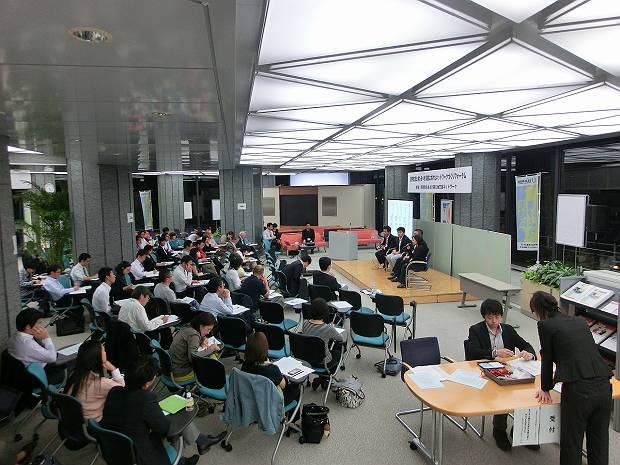
The event was organised by Peace Boat’s Disaster Volunteer Centre, with the help of sponsors including the Civilian Disaster Prevention and Disaster Area Support Network; corporate partner IBM Japan; intermediate support organizations such as Just Giving Japan; and NGO/NPO On the Road. With their cooperation, preparatory sessions have been held every two months since November 2011. The day the network was launched was also a chance to extend an invitation to other NGOs and NPOs involved with the Great East Japan Earthquake relief effort and support for future disasters. The event drew approximately 60 participants, comprised mainly of CSR representatives from various corporations and NGO/NPO employees. The two hour programme included a great deal of valuable hands-on advice, as participants shared their experiences with corporate volunteering and introduced examples of companies working together with local disaster relief organizations.
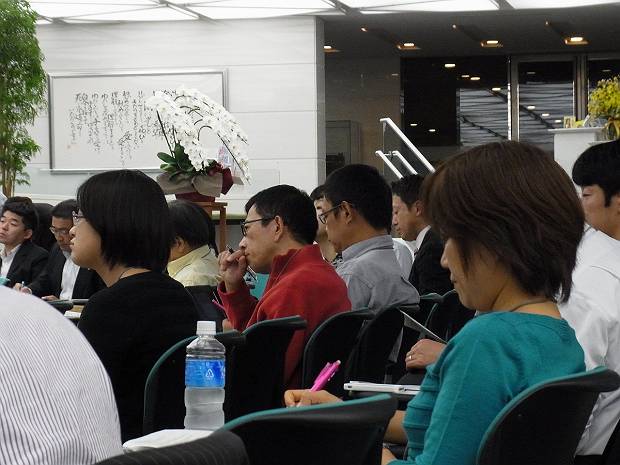
The first person to take the podium was Tamura Taro of the Institute for Human Diversity Japan, who gained valuable experience with relief efforts during the Great Hanshin-Awaji Earthquake which hit Kobe in 1995. After the Great East Japan Earthquake on March 11 2011, Mr Tamura joined the Cabinet Secretariat’s Disaster Volunteer Cooperation Office with the goal of facilitating cooperation between the public and private sectors. He currently acts as a senior official for party policy research at the Reconstruction Agency.
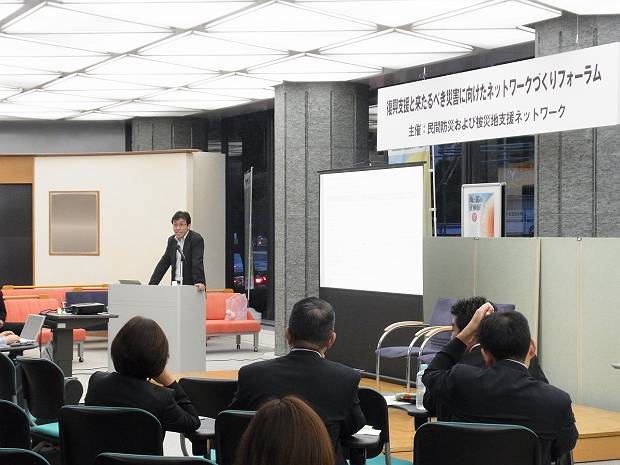
In addition to discussing the kind of relief efforts that will be necessary in the ongoing process to go forward in Tohoku, Mr Tamura also put forth a proposal for responding to future disasters. Japan’s birthrate continues to decline and the elderly comprise a larger segment of the population. Five or ten years from now, the demographic of volunteers able to provide disaster support will be very different. Hearing Mr Tamura’s talk reminded all there about questions of how we can respond to the challenges that might arise at such a time.
The next presenter was Peace Boat’s Disaster Relief Volunteer Centre President Yamamoto Takashi, who spoke about the achievements of corporate volunteer activities during the Great East Japan Earthquake. This was followed by a panel discussion featuring Sato Keisuke (Brand Promotion Dept, Social Activities Committee) from Bridgestone, which made the decision to send employees to volunteer at a very early stage; Tange Seiji (Head Office Environment Committee, Head of Planning and Management) from Taisei Corporation, which expanded volunteer activities in addition to donating its general contracting services; and Orikasa Mitsuko (CSR Section Leader, Corporate Strategy Planning Dept.) from Nippon Steel and Sumikin Engineering, which challenged its employees to make donations via Just Giving Japan, as well as investigating new ways of providing relief and support. These 3 panelists discussed the specific process involved when a corporation decides to volunteer, and shared examples of volunteer activities in the disaster areas.
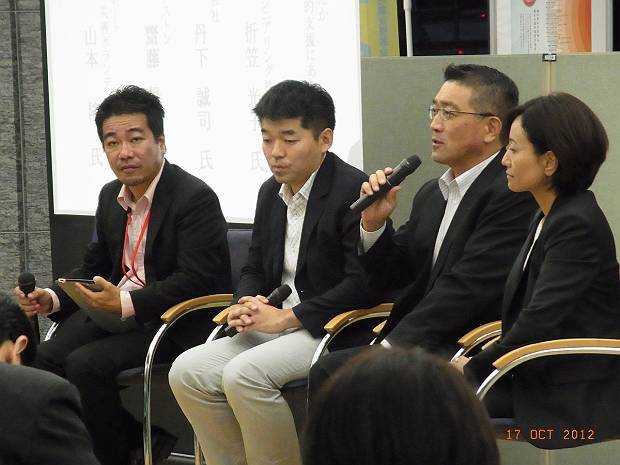
Wrapping up the event was a session to discuss the contribution of the corporate sector in going forward to help those affected by the Tohoku Disaster. Matsumura Gota, representative director of ISHINOMAKI 2.0, talked about the possibilities for creating new art and design-based projects, while making sure to remain grounded.
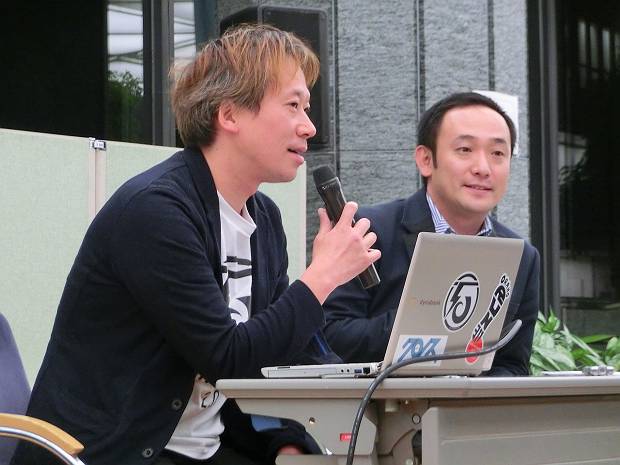
“Perhaps I can only say this because I was on the receiving end of the disaster, but I think now is the time when we can really experiment. Before the disaster, problems like the population drain were turning Ishinomaki into a ghost town. I don’t think recreating the old Ishinomaki is what we should be aiming for. I’m not saying this to get sympathy. I’ve been saying this from the very first days after the earthquake. Now we can cooperate with the corporations and designers who all share the same dreams and goals of ‘building a future’ for the area.”
===============================================
** For inquiries about the Civilian Disaster Prevention and Disaster Area Support Network, please contact:
Peace Boat Disaster Relief Volunteer Center (Ms Tayama)
TEL: 03-3363-7967 FAX: 03-3362-6073 MAIL: kyuen@pbv.or.jp
Case Study Training in Tokyo, Nov 25
November 13, 2012
Now recruiting students for Case study Training in Tokyo on November 25, 2012!
Volunteering at disaster-affected areas requires volunteer coordinators and leaders to consider many different situations. However, it is not easy to imagine these challenges and difficulties without real-life experiences.
This“case study”training has been organized by Peace Boat in cooperation with several university professors and students. The course offers a study programme where participants can learn through recreated scenarios which are based upon the actual experiences of volunteer leaders at disaster sites.
The participants will gain an ability to “imagine” and “make judgements” through discussions and workshops, and also have a chance to meet and learn from the experiences of people directly affected by disasters.
※This “case study” training is held as part of Peace Boat’s overall capacity and skill building programmes.
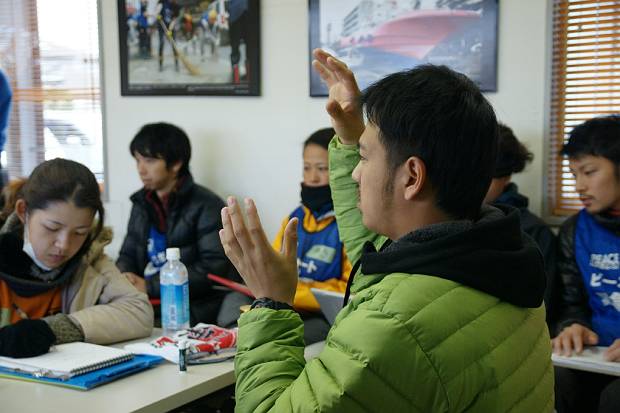
============================================================
Disaster volunteer training -skill-building-
“Case Study – imagine gain the ability to make good judgments-
============================================================
【Date and Time】 November 25, 2012 (Sunday) 10:00 – 16:30
【Venue】JICA TOKYO(2-49-5, Nishihara, Shibuya, Tokyo)
【Participation Fee】 3,000 yen *Members 2,000 yen
【Quota】 10 – 30 people (Prior booking required)
※ Minimum 10 participants required for training to take place.
【Targeted participants】
・Those who have completed Peace Boat’s ”Disaster Relief Training” (either: Elementary Disaster Volunteer Training, Disaster Relief Volunteer Certification, or Leader Training)
・Company employees or NGO staff who have been involved in relief operations.
・Those who have volunteer experience in a disaster relief operation and are committed to participate in relief operations in the future.
Programme content and schedule
10:00 Orientation and self-introductions
10:20 Video about the 11 March disaster and subsequent volunteer activities
10:50 Case Study 1: “Volunteering for who?”
(80 minutes) Discussion + Group presentation + Comments
12:10 Case study 2: “Consideration and coordination of volunteers
(80 minutes) Discussion + Group presentation + Comments
13:30 Lunch break
14:30 Case study 3: “Think about diversity and cooperation in a disaster scene”
(90 minutes) Discussion + Group presentation + Comments
16:00 Feedback + Q & A session
16:30 End
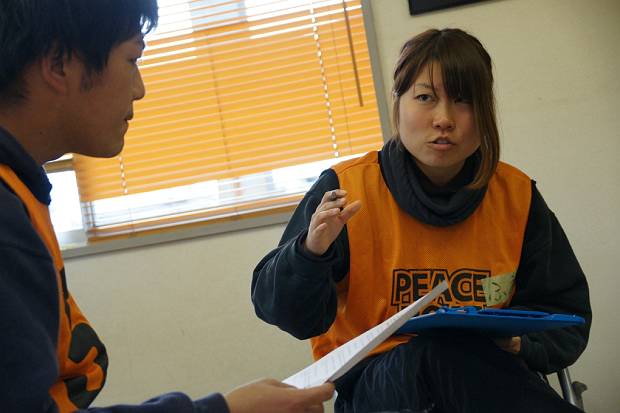
[In cooperation with]
Fukutake Shintaro (Sophia University Global Concern Laboratory)
Shibuya Tsutomu (Chukyo University International Liberal Arts Professor)
Kim Kyungmook (Chukyo University International Liberal Arts Assistant Professor)
Church World Service-Asia/Pacific
Please make a reservation with the Peace Boat Disaster Relief Volunteer Center.
▼TEL:03-3363-7967(10:00 – 19:00/Holidays: Sat, Sun, National holidays)
▼Email:training@pbv.or.jp (Japanese)
※ This training is offered in Japanese.
※ Please put“request for participation in a training case study”in the subject of the email and write your name, organization (company), phone number, and email address in the text.
※ Please see http://pbv.or.jp/privacy_policy.html for our policy on privacy information.
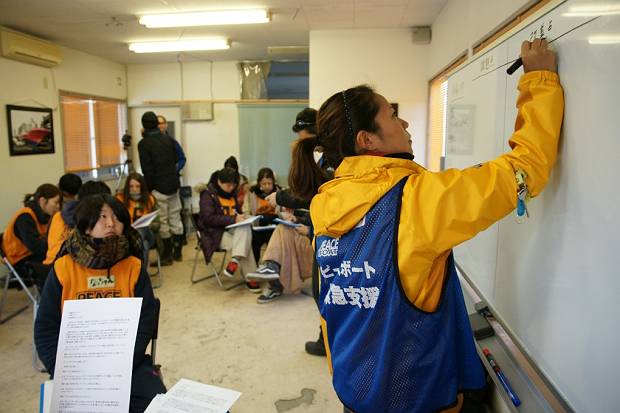
Fukushima & Venezuela Music Youth Ambassadors Special Concert – August 18!
August 9, 2012
A very special concert to welcome back the youth from Fukushima and to welcome to Japan the Venezual youth participating in the “Fukushima & Venezuela Music Youth Ambassadors – Widened Horizons: Opening the World’s Door for Fukushima’s Youth” will be held on Saturday August 18 in Tokyo!
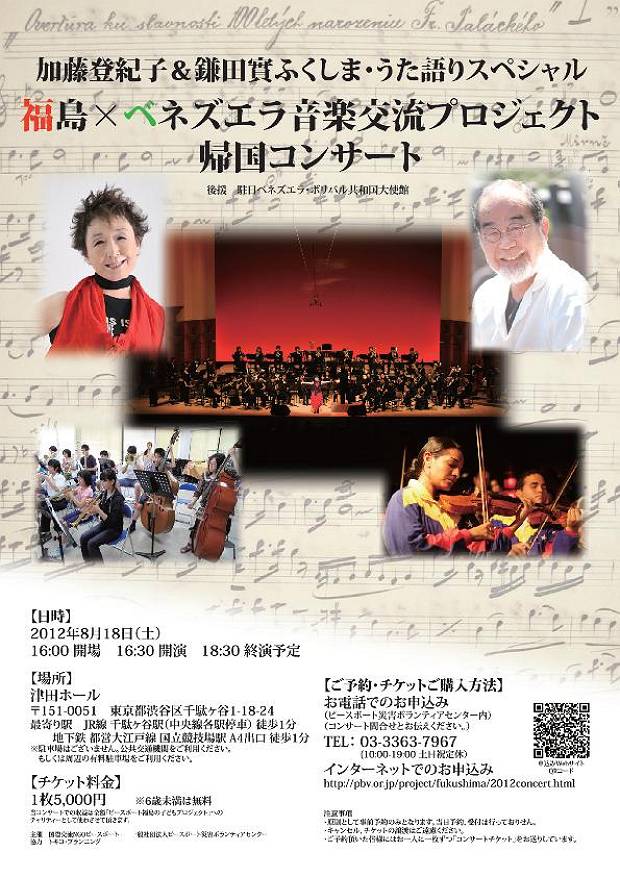
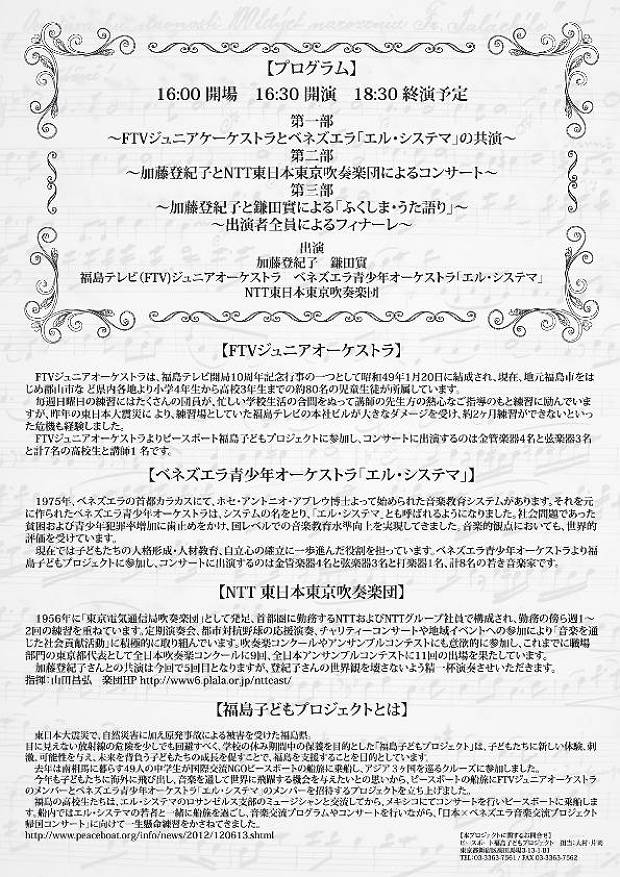
This concert will feature the seven high school student members of the Fukushima Television (FTV) Junior Orchestra and eight members of El Sistema, the world famous Venezuelan youth orchestra, performing the fruits of their voyage together onboard Peace Boat. There will also be vocal performances from renowned Japanese singer and project supporter Kato Tokiko Kato, and a special presentation by doctor and author, Kamata Minoru. Also featured will be special guests, NTT East Japan Orchestra.
Please see below to book to attend the concert, or for further English information contact us at relief[at]peaceboat.gr.jp
For booking, please visit here (Japanese)
Download the concert flyer here (PDF, 27.6MG)
TAGS: children • Fukushima • music • Peace Boat • peaceboat • youthHOPE for JAPAN 2011 Project
June 22, 2012
Sekai kara fukkou eno Ai no messages
(Messages of Love From the world for the reconstruction of Tohoku)
Peace Boat’s 73rd Global Voyage set sail from the port of Yokohama soon after March 11, 2011. Travelling to 15 countries in 85 days, Peace Boat held photo exhibitions at places visited to provide opportunities for people around the world to see the situation in the Tohoku region. This also provided an opportunity for Peace Boat to express its appreciation to people around the globe for their financial and humanitarian support for those affected by the March 11 disaster in Japan.
Another project was born onboard the ship at this time. A group of young participants took the initiative to start a new project, considering what each individual can do for Tohoku. They decided to just take pen and paper, and collect messages of love for Tohoku from across the world, in a project they called “Hope for Japan 2011.”
The two main participants who launched this project, Kamiya Takuma and Yazawa Yuko, are both in their 20s and first met onboard the ship. Calling for cooperation from their fellow participants onboard, over 200 people – from young to elderly and from all across from Japan – made contributions at ports and volunteered to help collect messages.
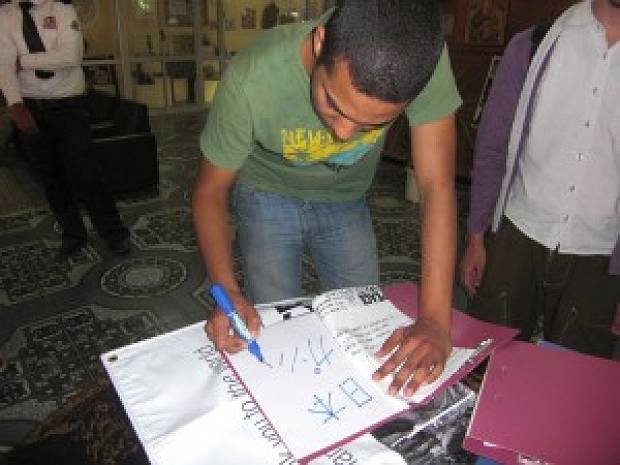
They prepared a hand-made banner saying, “Please write a message. HOPE for JAPAN”. The participants worked hard to communicate in English, however sometimes of course this was not adequate. However, whenever any language miscommunication occured, kind locals helped them numerous times. After the voyage ended, they decided to publish a book to tell Japanese people that the world cares about Japan, and also to express their appreciation for the people they met, conversations they had and messages they collected from all across the world..

Takuma and Yuko didn’t have a manuscript at that stage, any experiences in publishing, nor were they famous. Negotiating a deal with a publishing company was not successul, yet they decided to publish the book with their own funds and without support from a publisher. Further work was also needed to select photographs, proofread the manuscript, conduct additional interviews and so on. The most difficult work was to visit various Embassies in Japan, to find out the kinds of support that each country they visited has given for Tohoku.
The group overcame many difficulties, and finally the book “Sekai kara Fukkou e no Ai no message (Messages of love from the world, for the reconstruction of Tohoku)” was published! After publishing costs are covered, all profits will be donated to relief projects in Tohoku.
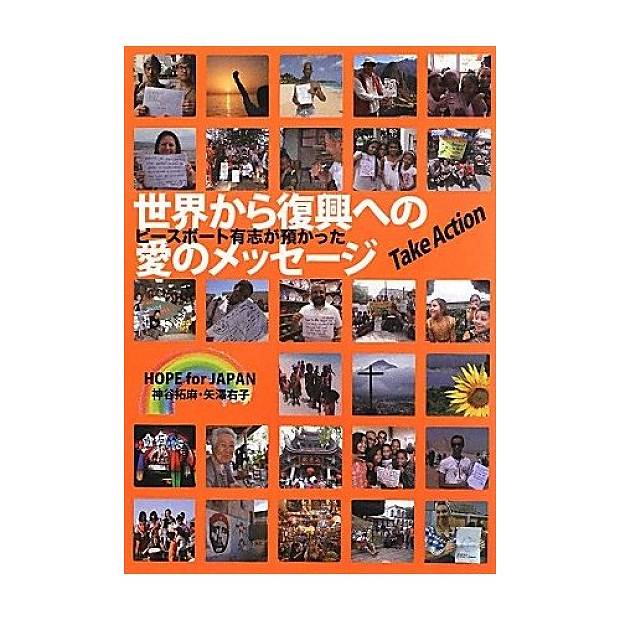
※ You can purchase this book at the Tokyo Peace Boat Centre, or online (Amazon.co.jp , Rakuten Books) * Japanese language only
TAGS: Japan • message • Peace Boat • peaceboat • Tohoku • Volunteer • voyage


